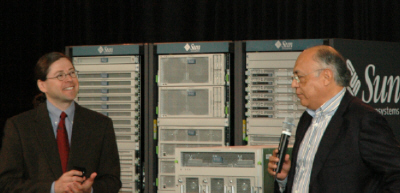Sun's modernized big iron

Sun CEO Jonathan Schwartz used the introduction of new, innovative high-end x86 servers to outline the latest iteration of his company’s strategy. As Schwartz has been saying for months, the tech industry is heading toward more uniform system infrastructure and operating systems underpinning a shared set of services aimed at a diverse set of customers. Sun is going to be a "systems innovator, to allow next generation of Network to become apparent, moving away from specialized systems," Schwartz said.

Sun CEO Jonathan Schwartz and AMD CEO Hector Ruiz, who not surprisingly said he was in awe of Sun's new products
Schwartz pegged the market opportunity as at least $250 billion, although he quipped that he might be off by a trillion. As he has said many times before, Schwartz doesn’t see any cessation of demand or limit to the opportunity for Sun—it’s about intercepting the demand.
Here’s what Schwartz wrote in his blog about uniform system infrastructure:
For the most part, customers love special purpose systems. The NAS filers, load balancers, storage switches and firewalls, even custom search appliances, solve a specific problem, do so with great focus, and are like novacaine on a technical problem. Have a pain? Numb it with an appliance.
There's only one part they don't love. Living with the economics.
Leaving high price tags aside, specialized products typically require specialized skills, customized management or versioning processes, and they tend to be difficult to integrate into increasingly uniform datacenter processes. (Southwest Airlines gets great economic advantage from only flying Boeing 737's - most CIO's crave a "737 datacenter," built on one OS, with shared services for all - yet most will admit to having inherited a Noah's Ark).
On the other hand, suppliers (like Sun) love general purpose systems. By design, general purpose systems, like general purpose servers or operating systems, aren't focused on one market. Instead, they focus on horizontal segments of the market (like web serving), and allow us to amortize R&D investments over a far broader opportunity. While allowing us and our customers to leverage the management, supply chains, administration, versioning and even ISV's that build up around very high volume platforms.
The new products don't fit in the high volume platform category. For example, the unique, 170-pound, $70,000 Sun Fire X4500 Data Server has four 64-bit Opteron processors, Solaris 10 with the ZFS file system and 24 TB of storage (48 500-GB drives). According to Andy Bechtolsheim, Sun co-founder and systems designer, the Sun Fire X4500 could serve as online database, Web and application server. Tim O'Reilly, CEO of O'Reilly Media and trendwatcher, called the Sun Fire x4500 the "server for Web 2.0," which earned big smiles from the Sun executives.
Andy Bechtolsheim, Sun co-founder and systems designer shows off one Sun's latest creations
Similarly, the new Sun Blade 8000 is dense and huge compared to chassis from HP and IBM. In response to a question during a Q&A, Bechtolsheim said, "There are two megatrends in servers: virtualization and multicore--quad-core, octo-core, hexadeci-core. You definitely want bigger blades with more memory and more input/output. It's not that our blades are large--their's are too small. We also care about the lifecycle of products. It looks big today, but trust me blades are going to get bigger." Schwartz chimed in that Bechtolsheim meant to say that "size matters."
Sun executive vice president of systems introduces Sun's new version of big iron
“We really believe there’s a market for high-end capability,” said John Fowler, Sun executive vice president for systems. “Sometimes you go where the competition isn’t. We have different products to have diff conversation in market, and over time we will fill out product line.” With x64 and VMware large scale applications can be run and large numbers of small applications can be consolidated. "It changes the whole data center," he said.
Asked why Sun doesn't use Intel's multicore processors, Bechtolsheim said, "Let me emphasize that we are happy with AMD roadmap. One thing great about Opteron is that it's easy to operate--no massive chip set or motherboard changes compared to the other [Intel]. The other side is not competitive in 4- or 8-socket technology....there is not enough scalablity or I/O in Intel today."
“In the next 3 to 5 years, we will continue to innovate at the systems level,” Schwartz concluded during his part of the product announcemet. The key, he said, is pulling together innovation across software, services, servers and storage to create innovative systems, and to foster that goal he is moving around executives to create more interdisciplinary teams and taking advantage of best practices and technology to allow for breakthrough economics. “It’s all based on thought leadership,” Schwartz said. “Looking for ways to out-think the competition is not all that clever—you need to deliver innovative product.”
As he was walking out of the announcement, Schwartz said to me, "Sun is back." On the thought leadership front, for sure. More forward thinking than IBM's On Demand outsourcing speak. Innovative technology, yes. Now we'll have to see if customers buy into Sun's modernized big iron vision.